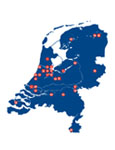Data collection at SHM: In constant development
| The number of people with HIV infection in the Netherlands continues to increase and due to improved treatment possibilities, the number of patients in follow-up is also increasing. Over the years, this has resulted in a substantial increase in the size of the Stichting HIV Monitoring’s (SHM’s) database. In 2010, no less than 14,640,052 data points were collected in the different HIV treatment centres. This was a 12% increase in comparison to the previous year. |  |
This quantitative increase in the size of the database was the reason that in 2010 SHM, together with the Clinical Research Unit (CRU) of the Academic Medical Center (AMC) of the University of Amsterdam (UvA), took a critical look at the various processes in data management. From this, several improvement steps were defined which would significantly impact the IT infrastructure and data management processes. Below are briefly discussed four areas for improvement that are currently running.
1) Lab Link
In 2010 a standardization project was started with the aim of fully automating data collection and transfer from all treatment centres. There is currently a pilot project with the MCA Alkmaar, whereby the laboratory results from the MCA Alkmaar are sent in HL7 messaging form via a secure connection to a server at the AMC. The official start of this project will take place in the autumn, and the various treatment sites will be approached by SHM and the CRU. SHM’s aim is to have the data transfer from all treatment centres fully automated within two years.
2) Merging Oracle and HIVREG
Until 2003, data from patients was collected in local Access databases, called HIVREG. In 2003, an Oracle Clinical database was implemented for centralised data collection via a secure Internet connection. To date, the differently formatted data from these two types of databases have been synchronised and merged for data analysis. Currently, SHM is busy with importing data from the HIVREG databases into the Oracle Clinical database so that data entry and corrections only take place in one database rather than two.
3) Patient Reports
The increasing size of the database has also meant that data reports per site, which often takes place via an Access Database, has been put under pressure. We are working hard on a solution whereby hospitals can access patient data via a secure Internet connection, using Microsoft Report Builder software. Using login details, the sites can run predefined 'queries' directly from the source tables. The existing patient reports have been, in cooperation with some data collectors, slightly modified and expanded to include more content.
4) Centre Specific (CS) Reports
Reports are also currently being developed that present ‘clean’ data in table form. These "Centre Specific (CS) Reports" aim to provide treatment teams in the treatment centres a picture of the developments, trends and issues within their own patient population every six months. This project is now in its final phase. A secure extranet website is being built wherein each HIV treatment centre can compare their data to the total data set by way of interactive graphs.
In the following newsletters, we will continue to keep you up-to-date with the developments within the various projects. In our next newsletter we hope to give you a glimpse of the total data collection by presenting our Centre Specific Reports.
